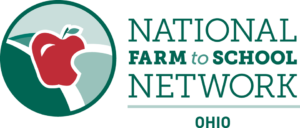Farm to School in the Cafeteria resources
-
-
-
Webinar: Starting Farm to School for Educators and Food Service Professionals (PDF).
-
Ohio Food Directors ToolKit (PDF).
-
Menus that Move
-
Serving Fresh Food in School Breakfasts, Lunches, After School Snacks & Summer Meal Programs
-
Specifying Geographic Preference
-
Distribution Models
-
Menu Planning and Ordering Tools
-
-
Menus that Move
Menus that Move is a set of seasonal cycle menus to help schools serve tasty meals that fit within the United States Department of Agriculture’s (USDA) new meal guidelines. Each seasonal cycle menu contains five weekly menus that have been entered into the USDA Menu Certification Worksheet and meet both the required meal components and also nutrient standards that have been entered into a USDA-approved software. Read more…
Parent Advocacy
Parents can play a huge role in improving the food at their child’s school. To get started, check out Chef Ann Foundation’s toolkit to Get Educated, Get Organized, and Take Action! You can also check out Parents United for Health Foods, a program of the Healthy Schools Campaign based in Chicago, to get inspired.
 Serving Fresh Food in School Breakfasts, Lunches, After School Snacks & Summer Meal Programs
Serving Fresh Food in School Breakfasts, Lunches, After School Snacks & Summer Meal Programs
Students taste the difference when one or more local food items are included in the salad bar, hot lunch, ala a carte option, or other meal service. Complete the Farm to School circle by telling the story of the farm from which the produce originated. Many schools do this by displaying a poster at the serving area. Schools and farmers can make connections through local farm and farmers markets. School buyers can also take advantage of the Ohio MarketMaker program to help simplify finding local suppliers. See how Ohio MarketMaker can help make connections for your school.
The USDA’s How Procurement Works: Planning, Executing, and Administering a Competitive Procurement is available as a free online procurement training, providing detailed information about each stage of the procurement process for the Child Nutrition Programs. For more information, including registration, visit the USDA Farm to School Team’s policy webpage.
Specifying Geographic Preference
The National School Lunch Program allows participating schools to purchase locally using informal procurement, which includes smaller contracts (in Ohio, this means contracts less than $100,000). Using informal procurement, schools must obtain quotes from at least 3 farmers or vendors (of their choice — all may be local), and are required to select the vendor offering the lowest cost.
The National School Lunch Program allows schools to apply a geographic preference in formal bids. In Ohio, formal procurement includes all contracts over $150,000. Schools interested in purchasing local foods can give preference points to local bids. While price may earn the majority of points, other bid categories like variety availability, freshness, and delivery schedule may be nearly as important to you. Identify bids that meet your selection criteria and determine products to purchase from local farmers.
For more information on applying geographic preference, see the USDA’s Applying Geographic Preference Q&A sheet.
Check out ODE’s Guide to Procurement, which includes a sample invitation to bid, and a sample contract.
Distribution Models
There are many avenues for purchasing local foods. Choose a distribution model that works for you!
Direct Marketing
School food service directors can buy directly from individual farmers. This procurement method allows schools to develop relationships with producers without a middle man, which can keep costs down. Additionally, schools that have a direct relationship with a farmer may request specific items if they are needed, and may even request that a farmer plant specific items for them. However, the administration costs of direct marketing can get high when schools buy from more than one farmer. If one farmer is not able to satisfy your requests, another procurement method may work better for you.
Farmer Cooperative
Many farmers may pool their products or resources to form a cooperative. Cooperatives may have a wider variety and more consistent supply than a single farmer. To find a cooperative, contact your county extension office.
Wholesaler
Many wholesalers distribute local produce! Ask your distributor if they purchase from local farms. If you need help finding a distributor that works with local farms, contact Ohio Farm to School.
DoD Fresh
Department of Defense establishes FTS partnerships between local producers/producer organizations, and then coordinates and oversees the program. DOD operates as a broker, taking orders from school districts and purchasing fruits and vegetables from produce houses, and in exchange schools pay a 5.8% commission.
Menu Planning
Search the following producer listings to find fruit and vegetables in your neighborhood:
Food Safety
Food safety is a major concern for schools and for local producers. To ensure safety, most local producers follow Good Agricultural Practices (GAP). To learn more about GAP and local food safety, see:
- USDA’s GAP Audit Checklist
- Cornell GAP
- OSU Extension Fact Sheet—Food Safety for Fruits and Vegetables(PDF)
Other Resources
- Food Research and Action Center State of the States 2010 (Ohio)
-
Webinar: Starting Farm to School for Educators and Food Service Professionals(PDF)
-
Ohio Food Directors ToolKit(PDF)
-
Menus that Move
-
Serving Fresh Food in School Breakfasts, Lunches, After School Snacks & Summer Meal Programs
-
Specifying Geographic Preference
-
Distribution Models
-
Menu Planning and Ordering Tools
Menus that Move
Menus that Move is a set of seasonal cycle menus to help schools serve tasty meals that fit within the United States Department of Agriculture’s (USDA) new meal guidelines. Each seasonal cycle menu contains five weekly menus that have been entered into the USDA Menu Certification Worksheet and meet both the required meal components and also nutrient standards that have been entered into a USDA-approved software. Read more…
Parent Advocacy
Parents can play a huge role in improving the food at their child’s school. To get started, check out Chef Ann Foundation’s toolkit to Get Educated, Get Organized, and Take Action! You can also check out Parents United for Health Foods, a program of the Healthy Schools Campaign based in Chicago, to get inspired.
 Serving Fresh Food in School Breakfasts, Lunches, After School Snacks & Summer Meal Programs
Serving Fresh Food in School Breakfasts, Lunches, After School Snacks & Summer Meal Programs
Students taste the difference when one or more local food items are included in the salad bar, hot lunch, ala a carte option, or other meal service. Complete the Farm to School circle by telling the story of the farm from which the produce originated. Many schools do this by displaying a poster at the serving area. Schools and farmers can make connections through local farm and farmers markets. School buyers can also take advantage of the Ohio MarketMaker program to help simplify finding local suppliers. See how Ohio MarketMaker can help make connections for your school.
The USDA’s How Procurement Works: Planning, Executing, and Administering a Competitive Procurement is available as a free online procurement training, providing detailed information about each stage of the procurement process for the Child Nutrition Programs. For more information, including registration, visit the USDA Farm to School Team’s policy webpage.
Specifying Geographic Preference
The National School Lunch Program allows participating schools to purchase locally using informal procurement, which includes smaller contracts (in Ohio, this means contracts less than $100,000). Using informal procurement, schools must obtain quotes from at least 3 farmers or vendors (of their choice — all may be local), and are required to select the vendor offering the lowest cost.
The National School Lunch Program allows schools to apply a geographic preference in formal bids. In Ohio, formal procurement includes all contracts over $150,000. Schools interested in purchasing local foods can give preference points to local bids. While price may earn the majority of points, other bid categories like variety availability, freshness, and delivery schedule may be nearly as important to you. Identify bids that meet your selection criteria and determine products to purchase from local farmers.
For more information on applying geographic preference, see the USDA’s Applying Geographic Preference Q&A sheet.
Check out ODE’s Guide to Procurement, which includes a sample invitation to bid, and a sample contract.
Distribution Models
There are many avenues for purchasing local foods. Choose a distribution model that works for you!
Direct Marketing
School food service directors can buy directly from individual farmers. This procurement method allows schools to develop relationships with producers without a middle man, which can keep costs down. Additionally, schools that have a direct relationship with a farmer may request specific items if they are needed, and may even request that a farmer plant specific items for them. However, the administration costs of direct marketing can get high when schools buy from more than one farmer. If one farmer is not able to satisfy your requests, another procurement method may work better for you.
Farmer Cooperative
Many farmers may pool their products or resources to form a cooperative. Cooperatives may have a wider variety and more consistent supply than a single farmer. To find a cooperative, contact your county extension office.
Wholesaler
Many wholesalers distribute local produce! Ask your distributor if they purchase from local farms. If you need help finding a distributor that works with local farms, contact Ohio Farm to School.
DoD Fresh
Department of Defense establishes FTS partnerships between local producers/producer organizations, and then coordinates and oversees the program. DOD operates as a broker, taking orders from school districts and purchasing fruits and vegetables from produce houses, and in exchange schools pay a 5.8% commission.
Menu Planning
Search the following producer listings to find fruit and vegetables in your neighborhood:
Food Safety
Food safety is a major concern for schools and for local producers. To ensure safety, most local producers follow Good Agricultural Practices (GAP). To learn more about GAP and local food safety, see:
- USDA’s GAP Audit Checklist
- Cornell GAP
- OSU Extension Fact Sheet—Food Safety for Fruits and Vegetables(PDF)
Other Resources
- Food Research and Action Center State of the States 2010 (Ohio)








